Akkad › Dur-Sharrukin » Ancient origins
Articles and Definitions › Contents
- Akkad › Antique Origins
- Dur-Sharrukin › Antique Origins
Ancient civilizations › Historical and archaeological sites
Akkad › Antique Origins
Definition and Origins

No one knows where the city of Akkad was located, how it rose to prominence, or how, precisely, it fell; yet once it was the seat of the Akkadian Empire which ruled over a vast expanse of the region of ancient Mesopotamia. It is known that Akkad (also given as Agade) was a city located along the western bank of the Euphrates River possibly between the cities of Sippar and Kish (or, perhaps, between Mari and Babylon or, even, elsewhere along the Euphrates). According to legend, it was built by the king Sargon the Great (who ruled 2334-2279 BCE) who unified Mesopotamia under the rule of his Akkadian Empire and set the standard for future forms of government in Mesopotamia. Sargon (or his scribes) claimed that the Akkadian Empire stretched from the Persian Gulf through modern-day Kuwait, Iraq, Jordan, Syria (possibly Lebanon) through the lower part of Asia Minor to the Mediterranean Sea and Cyprus (there is also a claim it stretched as far as Crete in the Aegean ).While the size and scope of the empire based in Akkad is disputed, there is no doubt that Sargon the Great created the first multi-national empire in the world.
THE KING OF URUK & THE RISE OF SARGON
The language of the city, Akkadian, was already in use before the rise of the Akkadian Empire (notably in the wealthy city of Mari where vast cuneiform tablets have helped to define events for later historians) and it is possible that Sargon restored Akkad, rather than built it. It should also be noted that Sargon was not the first ruler to unite the disparate cities and tribes under one rule. The King of Uruk, Lugalzagesi, had already accomplished this, though on a much smaller scale, under his own rule. He was defeated by Sargon who, improving on the model given him by Uruk, made his own dynasty larger and stronger.The historian Gwendolyn Leick writes, "According to his own inscriptions, he [Sargon] campaigned widely beyond Mesopotamia and secured access to all the major trade routes, by sea and by land" ( The AZ of Mesopotamia, 8). While Lugalzagesi had succeeded in subjugating the cities of Sumer, Sargon was intent on conquering the known world. The historian Durant writes, "East and west, north and south, the mighty warrior marched, conquering Elam, washing his weapons in symbolic triumph in the Persian Gulf, crossing western Asia, reaching the Mediterranean, and establishing the first great empire in history" (121-122). This empire stabilized the region of Mesopotamia and allowed for the development of art, literature, science, agricultural advances, and religion.
THERE WERE FIVE RULERS OF AKKAD: SARGON, RIMUSH, MANISHTUSU, NARAM-SIN AND SHAR- KALI -SHARRI.
According to the Sumerian King List, there were five rulers of Akkad: Sargon, Rimush, Manishtusu, Naram-Sin (also known as Naram-Suen) and Shar-Kali-Sharri who maintained the dynasty for 142 years before it collapsed. In this time Akkadian came to replace Sumerian as the lingua franca except in sacred services and Akkadian dress, writing, and religious practices infiltrated the customs of the conquered in the region. A thorough understanding of the rise and fall of Akkad (relatively speaking) is best gained through an examination of the rulers of the city and the empire they maintained.
SARGON'S RULE
Sargon the Great either founded or restored the city of Akkad and ruled from 2334-2279 BCE. He conquered what he called "the four corners of the universe" and maintained order in his empire through repeated military campaigns. The stability provided by this empire gave rise to the construction of roads, improved irrigation, a wider sphere of influence in trade, as well as the above mentioned developments in arts and sciences. The Akkadian Empire created the first postal system where clay tablets inscribed in cuneiform Akkadian script were wrapped in outer clay envelopes marked with the name and address of the recipient and the seal of the sender. These letters could not be opened except by the person they were intended for because there was no way to open the clay envelope save by breaking it.
In order to maintain his presence throughout his empire, Sargon strategically placed his best and most trusted men in positions of power in the various cities. The "Citizens of Akkad", as a later Babylonian text calls them, were the governors and administrators in over 65 different cities. Sargon also cleverly placed his daughter, Enheduanna, as High Priestess of Inannaat Ur and, through her, seems to have able to manipulate religious/cultural affairs from afar. Enheduanna is recognized today as the world's first writer known by name and, from what is known of her life, she seems to have been a very able and powerful priestess in addition to creating her impressive Hymns to Inanna.
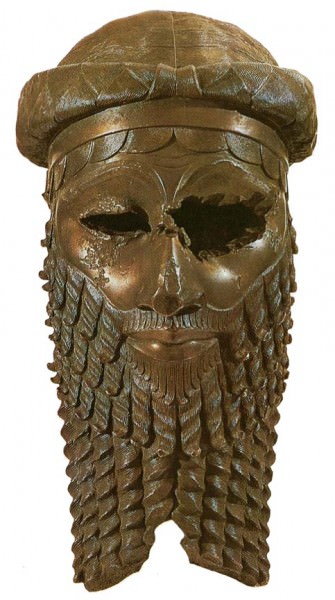
Akkadian Ruler
SARGON'S SUCCESSORS: RIMUSH & MANISHTUSU
Sargon reigned for fifty-six years and after his death was succeeded by his son Rimush (reigned 2279-2271 BCE) who maintained his father's policies closely. The cities rebelled after Sargon's death and Rimush spent the early years of his reign restoring order. He campaigned against Elam, whom he defeated, and claimed in an inscription to bring great wealth back to Akkad. He ruled for only nine years before he died and was succeeded by his brother Manishtusu (reigned 2271-2261 BCE).There is some speculation that Manishtusu brought about his brother's death to gain the throne.
History repeated itself after the death of Rimush and Manishtusu had to quell widespread revolts across the empire before engaging in the business of governing his lands. He increased trade and, according to his inscriptions, engaged in long-distance trade with Magan and Meluhha (thought to be upper Egypt and the Sudan). He also undertook great projects in construction throughout the empire and is thought to have ordered the construction of the Ishtar Temple at Nineveh which was considered a very impressive piece of architecture. Further, he undertook land reform and, from what is known, improved upon the empire of his father and brother. Manishtusu's obelisk, describing the distribution of parcels of land, may be viewed today in the Louvre Museum, Paris. His death is somewhat of a mystery but, according to some scholars, Leick among them, "Manishtusu was killed by his courtiers with their cylinder seals" though no definite motive has been offered for the killing( The AZ of Mesopotamia, 111).
NARAM-SIN: GREATEST OF THE AKKADIAN KINGS
Manishtusu was succeeded by his son Naram-Sin (also Naram-Suen) who reigned from 2261-2224 BCE. Like his father and uncle before him, Naram-Sin had to suppress rebellions across the empire before he could begin to govern but, once he began, the empire flourished under his reign. In the thirty-six years he ruled, he expanded the boundaries of the empire, kept order within, increased trade, and personally campaigned with his army beyond the Persian Gulf and, possibly, even to Egypt.The Victory Stele of Naram-Sin (presently housed in the Louvre) celebrates the victory of the Akkadian monarch over Satuni, king of the Lullubi (a tribe in the Zagros Mountains) and depicts Naram-Sin ascending the mountain, trampling on the bodies of his enemies, in the image of a god. Like his grandfather, he claimed himself "king of the four quarters of the universe" but, in a bolder move, began writing his name with a sign designating himself a god on equal footing with any in the Mesopotamian pantheon.
In spite of his spectacular reign, considered the height of the Akkadian Empire, later generations would associate him with The Curse of Agade, a literary text ascribed to the Third Dynasty of Ur but which could have been written earlier. It tells the fascinating story of one man's attempt to wrest an answer from the gods by force; and that man is Naram-Sin. According to the text, the great Sumerian god Enlil withdrew his pleasure from the city of Akkad and, in so doing, prohibited the other gods from entering the city and blessing it any longer with their presence. Naram-Sin does not know what he could have done to incur this displeasure and so prays, asks for signs and omens, and falls into a seven-year depression as he waits for an answer from the god. Finally, tired of waiting, he draws up his army and marches on Enlil's temple at the Ekur in the city of Nippur which he destroys. He "sets his spades against its roots, his axes against the foundations until the temple, like a dead soldier, falls prostrate" (Leick, The Invention of the City, 106). This attack, of course, provokes the wrath not only of Enlil but of the other gods who send the Gutium "a people who know no inhibition, with human instincts but canine intelligence and with monkey features" (106) to invade Akkad and lay it waste. There is widespread famine after the invasion of the Gutians, the dead remain rotting in the streets and houses, and the city is in ruin and so, according to the tale, ends the city of Akkad and the Akkadian Empire, a victim of one king's arrogance in the face of the gods.
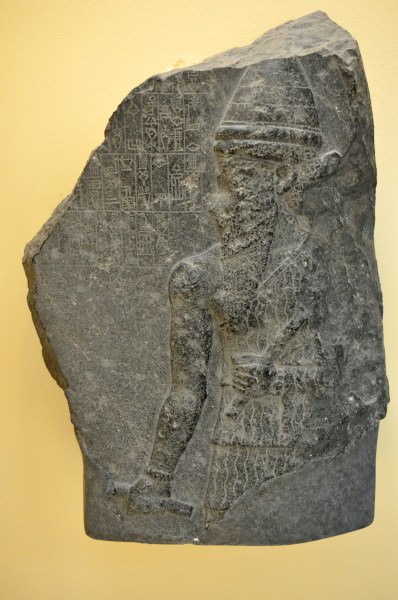
Stele of the Akkadian king Naram-Sin
There is, however, no historical record of Naram-Sin ever reducing the Ekur at Nippur by force nor destroying the temple of Enlil and it is thought that "The Curse of Agade" was a much later piece written to express "an ideological concern for the right relationship between the gods and the absolute monarch" (Leick, 107) whose author chose Akkad and Naram-Sin as subjects because of their, by then, legendary status. According to historical record, Naram-Sin honored the gods, had his own image placed beside theirs in the temples, and was succeeded by his son, Shar-Kali-Sharri who reigned from 2223-2198 BCE.
THE DECLINE OF AKKAD
Shar-Kali-Sharri's reign was difficult from the beginning in that he, too, had to expend a great deal of effort in putting down revolts after his father's death but, unlike his predecessors, seemed to lack the ability to maintain order and was unable to prevent further attacks on the empire from without. Leick writes, "Despite his efforts and successful military campaigns, he was not able to protect his state from disintegration and, after his death, written sources dried up in a time of increased anarchy and confusion" ( The AZ of Mesopotamia, 159). Interestingly, it is known that "his most important building project was the reconstruction of the Temple of Enlil at Nippur" and perhaps this event, coupled with the invasion of the Gutians and a widespread famine, gave rise to the later legend which grew into The Curse of Agade. Shar-Kali-Sarri waged almost continual war against the Elamites, the Ammorites and the invading Gutians but it is the Gutian Invasion which has been most commonly credited with the collapse of the Akkadian Empire and the Mesopotamian dark age which ensued. Recent studies, however, claim that it was most likely climate change which caused a famine and, perhaps, disruption in trade, weakening the empire to the point where the type of invasions and rebellions which, in the past, were crushed, could no longer be dealt with so easily. The last two kings of Akkad following the death of Shar-Kali-Sharri, Dudu and his son Shu-Turul, ruled only the area around the city and are rarely mentioned in association with the empire. As with the rise of the city of Akkad, its fall is a mystery and all that is known today is that, once, such a city existed whose kings ruled a vast empire, the first empire in the world, and then passed on into memory and legend.
Dur-Sharrukin › Antique Origins
Definition and Origins
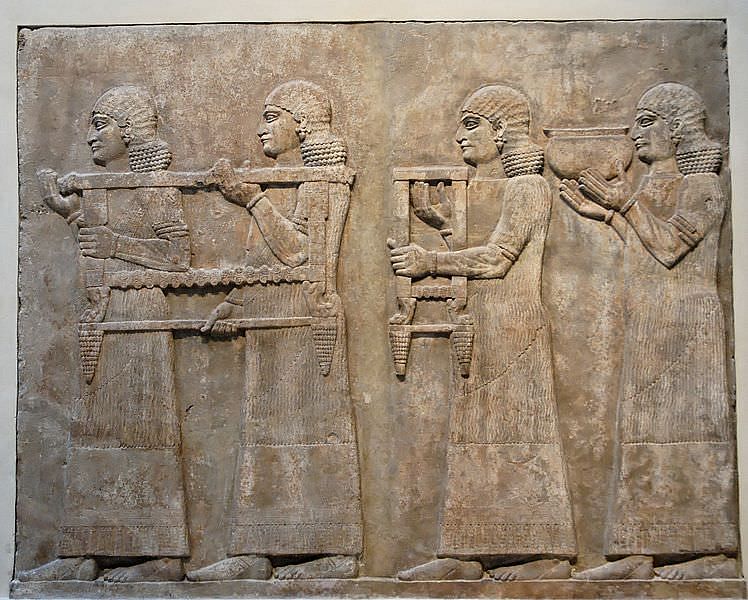
Dur-Sharrukin (modern day Khorsabad, Iraq) was a city built by Sargon II of Assyria (reigned 722-705 BCE) as his new capital. The name means “Fortress of Sargon ” and the building project became the king's near obsession as soon as it was conceived. The city covered 1.11 square miles (1.78 kilometers) with a length of 5,770 feet (1,758.6 meters) and a width of 5,364 feet (1,635 meters) and was surrounded by a wall which was 45 feet (14 meters) thick and 39 feet (12 meters) high. The city was built, from Sargon's design, to form a near perfect square from which rose a “palace without rival” (as Sargon described it) and a four-story ziggurat. The historian Stephen Bertman comments on the construction and design writing :
Sargon's capital city was over a mile square and its design became his preoccupation. The city's dimensions, for example, were based on the numerological value of Sargon's name. Tablets describing the story of the palace's construction were deposited in its cornerstone with the identical text repeated on individual tablets of copper, lead, silver, gold, limestone, magnesite, and lapis lazuli, while paintings illustrated how cedar wood was imported from Lebanon to provide needed timber. Colossal stone bulls with wings and human heads guarded its entranceways. And the walls of the palace were decorated with so much sculpture that the panels, if laid end to end, would stretch for a mile (19).
Construction began in 717 BCE and would continue for the next ten years. Sargon II was away on campaign during much of this time but kept in touch with his son, the crown prince Sennacherib, regarding the city's progress. He moved in to his new palace in 706 BCE but died on campaign a year later. After his death, the city was abandoned.
SARGON II HAD WANTED A CITY MORE BEAUTIFUL THAN KALHU OR ASHUR, A CITY NO ONE BEFORE HIM HAD LIVED IN, AND NOW HE HAD IT.
THE NEED FOR A NEW CAPITAL
The city of Ashur had been the traditional capital of the Assyrian Empire until the reign of King Ashurnasirpal II (884-859 BCE) who moved the capital to his newly-built city of Kalhu (also known as Nimrud ). Ashurnasirpal II decided on this move in order to separate his reign from those of his predecessors but also because the people of Ashur had become more independent owing to the great wealth and prestige of the city. Ashurnasirpal II felt he could no longer count on the populace to unwaveringly support him and wanted a new city, with a new palace, to assert his authority. Kalhu proved to be just the city he was looking for. It had first been built under the reign of Shalmaneser I (reigned 1274-1245 BCE) but had become dilapidated in the years since his reign. Ashurnasirpal II renovated the city, rebuilt the temple, had a new palace constructed, and inaugurated the city as his capital in 879 BCE. Kalhu served the kings of Assyria over the next century but, in 746 BCE, the usurper Tiglath Pileser III (reigned 745-727 BCE) overthrew the ruling monarch and took the throne. Regarding this, the historian Karen Radner writes:
That Kalhu's elite could no longer be seen as unquestioningly loyal to whoever happened to be king became very clear in 746 BCE. In that year, a rebellion against king Ašš ur -nerari V (754-745 BCE) started in Kalhu, in the very centre of the Assyrian state. The revolt was successful and eventually resulted in the ascension of Tiglath-Pileser III to the throne. Having profited from Kalhu's new-found independence from the royal court, he and his chosen heir Shalmaneser V (726-722 BCE) had little reason to fear it. Sargon II, however, faced fierce resistance to his rule after he ousted his brother Shalmaneser in 722 BCE and usurped royal power. Rebellions arose in the western provinces but also, and much more worryingly, in the Assyrian heartland. After he managed to crush the opposition in 720 BCE, he exiled those of his enemies in central Assyria who had survived. Moreover, he immediately took steps to relocate the court and central administration (1).
Dur-Sharrukin was envisaged as a completely new beginning for Sargon II. He purchased the land from an agricultural community called Magganubba and claimed to have paid the going market price without invoking any kind of royal privilege.Sargon II writes in one inscription:
Magganubba, which lies at the foot of Mount Muṣri and towers above a spring and the surroundings of Nineveh - none of the 350 earlier regents of Assyria realized its favorable location, understood the benefits of its settlement or commanded to dig a canal there. I planned and plotted day and night how to settle this city and to build a sanctuary as the seat of the great gods and palaces as the residence of my rule, and therefore commanded their construction (Khorsabad cylinder inscription, ll. 44-49)
Once the land had been purchased and construction had begun, Sargon II needed to leave on military campaigns to secure his empire. He continued to oversee his project from afar, however, as is clear from his letters to his son and to those directly involved in building the city.
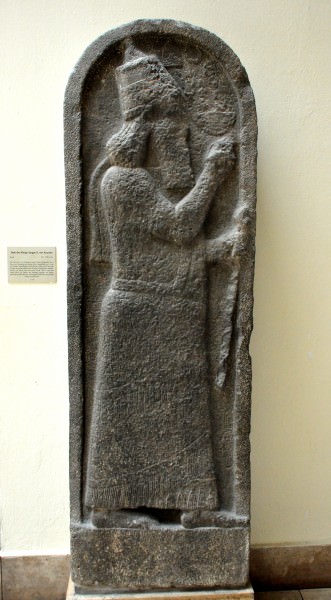
Sargon II's Stele
CONSTRUCTION OF THE CITY
Sargon II was no longer interested in ruling from Kalhu and wanted the city built quickly. He was also interested in quality, however, and wanted to make sure it was built well. He canceled the debts of workers in order to procure a steady stream of labor and had his overseers give incentives to skilled workers. He also, no doubt, used the forced labor of prisoners of war and those civilian populations which had been relocated following conquest (such as the people of Israel and Samaria, whom he conquered early in his reign, c. 720 BCE). His level of personal involvement in the project is made clear through the letters he sent home. The historian Marc Van De Mieroop writes:
A total of 113 letters can be associated with the building of Dur-Sharrukin, a tenth of all preserved letters from his reign. They involve twenty-six provincial governors, which shows how resources from the entire empire were used. Six letters seem to have been written by the king himself, demanding materials or labor. Three of them are translated here:1 Letter found in NinevehThe king's word to the governor of Kalhu: 700 bales of straw and 700 bundles of reed, each bundle more than a donkey can carry, must arrive in Dur-Sharrukin by the first of the month Kislev. Should one day pass by, you will die.2 Letters found in KalhuThe 1100 limestones that Bel-lishir-talaktu is loading, let them be brought to me in Dur-Sharrukin quickly!Addressed to the second vizier.700 limestones that Bel-lishir-talaktu is loading, quickly bring them to me in Dur-Sharrukin! Addressed to the eunuchs (235).
The city rose steadily through the efforts of a massive labor force even though, at times, there were accidents and delays. One such accident was the loss of two winged bull colossi in the river Tigris. The official overseeing the movement of the statues wrote to the king saying,
To the king, my lord: your servant Assur -bani. Good health to the king, my Lord! Assur-sumi-ke'in called me to help and loaded the bull colossi on the boats, but the boats could not carry the load and sank. Now, although it cost me a great trouble, I have now hauled them up again.
Between 713-710 BCE Sargon II remained, more or less, in Kalhu and regularly oversaw the construction of his city. In 710 BCE he felt he had to finally deal with a problem which had bested him early in his reign. A tribal chief named Merodach-Baladan had taken Babylon and, with Elamite allies, had defeated Sargon II's forces in c. 719 BCE and had then claimed the throne of Babylon and the southern reaches of Mesopotamia. Sargon II again entrusted the building of Dur-Sharrukin to Sennacherib and marched his forces against Elam.
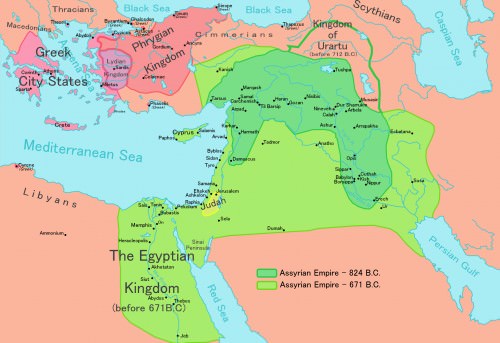
Neo-Assyrian Empire
BABYLON, DEATH, & THE END OF DUR-SHARRUKIN
Sargon II had been defeated previously by the Elamites and Babylonians because he faced them in a frontal assault on the field. This time he swung his armies to the east and first defeated Elam in order to deprive Babylon of its allies. Merodach-Baladan fled the city and Sargon II entered Babylon, had himself crowned king, and accepted the territories of the south in his role as liberator. He then remained at Babylon for the next three years until word reached him that his city was complete and he could move into his palace.
The city was not actually complete. The walls were done and most of the buildings and, most importantly, the palace, but excavations at the site and ancient letters indicate there was still some significant work to be done. Even so, the city was very impressive. The historian Gwendolyn Leick writes:
There were seven gates, each dedicated to an Assyrian god. Within a separate enclosure stood the palace and the administrative complex known as the “Palace without Rival”. According to the French excavators, it contained more than 210 rooms, grouped around three courtyards. The portals were guarded by colossal human-headed, winged bulls made of stone, and the walls of the palace were lined with relief-covered limestone slabs that showed the triumph of the Assyrian army and the deeds of Sargon. There were several sanctuaries at Dur-Sharrukin; the most notable was dedicated to the god Nabu and decorated with glazed tiles (51-52).
Further, there was the great ziggurat of Dur-Sharrukin: a four-story structure with a spiral staircase winding up around it. Each of the levels was painted a different color: white, black, red, and blue. The doors of the palace were bronze, while carved ivory decorated the walls and ceilings. The reliefs that lined the walls depicted Sargon II as a mighty king who destroyed his enemies and built towering monuments. The historian Susan Wise Bauer comments on this, writing how the reliefs “show his greatness. His huge figure pushes even the forms of the gods into the background” (381). He had wanted a city more beautiful than Kalhu or Ashur, a city no one before him had lived in, and now he had it.
He did not enjoy it for very long. Sargon II moved into his grand palace in 706 BCE and, in 705 BCE, was killed in battle. The Tabal people of Anatolia had risen against the Assyrian Empire and, instead of sending a general to take care of the problem, Sargon II led his army himself. He was killed on the field and the fighting was so fierce that his men could not retrieve his body.This was considered a bad omen by the people of Assyria who concluded that Sargon II must have committed some terrible sin for the gods to have deserted him so completely when he needed them most. Since Dur-Sharrukin was so closely associated with the king, it was thought to have been tainted by whatever transgression against the gods he had committed and so was abandoned. Sennacherib moved the capital to Nineveh and initiated his own building projects there. Anything which could be moved was taken from Dur-Sharrukin and brought to Nineveh. The city was deserted. While some modern-day scholars claim that Dur-Sharrukin continued on as a provincial capital, others contend that it became effectively a ghost town after the move to Nineveh. The discrepancies in these views come from different interpretations of the modern-day site and the ancient inscriptions.
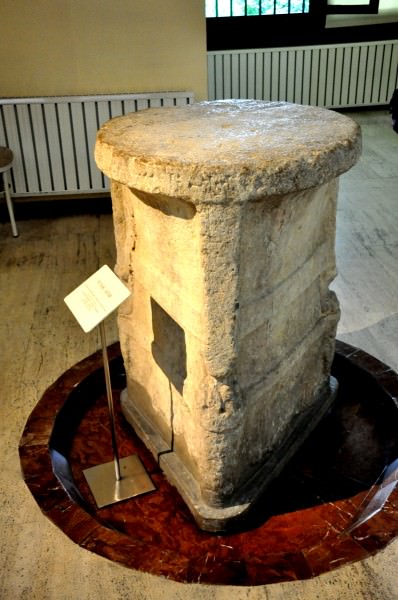
An Altar from Dur-Sharrukin
COLLAPSE & LATER DISCOVERY
Dur-Sharrukin eventually collapsed in the fires which took the region after the fall of the Assyrian Empire in 612 BCE. The combined forces of the Persians, Medes, Babylonians, and others swept through the cities of the Assyrians following the death of Sargon II's great-grandson, King Ashurbanipal, in 627 BCE and destroyed them. In time, the ruins were buried by the sands and the city was forgotten. The settlement known as Khorsabad came to be established on the spot, and then, in 1873 CE the archaeologist Paul Emile Botta began excavations there. These were later carried on by another archaeologist named Victor Place. These men were accompanied, as was standard practice, by artists who would sketch the ruins and the artifacts which were to be moved in situ. Artists like Eugene Flandin and Felix Thomas made careful drawings of every artifact discovered at Dur-Sharrukin, and it was very fortunate that they did.
One boatload of treasures that was being shipped down the Tigris River in 1853 CE was attacked by Bedouins and sank, while another boatload in 1855 CE sank under the weight of the artifacts which had been loaded on to it. The second sinking resulted in the loss of two bull colossi, possibly the same two colossi which had sunk the boats in the 8th century BCE. Unlike the workmen under Sargon II, however, no attempts were made in the 19th century CE to retrieve the treasures from the bottom of the Tigris River and they remain there to the present day. In part due to military conflicts in the region, any plans to raise the sunken treasures in the latter 20th and early 21st centuries CE have never been implemented.
Those artifacts which did wind up leaving the country may be viewed today in the British Museum, the Louvre, The Oriental Institute of Chicago in the USA and, in country, at the Archaeological Museum in Iraq. Excavations at the site continued into the mid-20th century CE, with the Oriental Institute of Chicago overseeing the work there from 1928-1935 CE. The Iraqi Department of Antiquities took over the site in the 1950's CE, and further excavations were conducted under their authority with finds going to the museum in Baghdad. No further work has been carried out at Dur-Sharrukin and, as with the artifacts at the bottom of the Tigris River, this is partly due to armed conflict in the region.
LICENSE:
Article based on information obtained from these sources:with permission from the Website Ancient History Encyclopedia
Content is available under License Creative Commons: Attribution-NonCommercial-ShareAlike 3.0 Unported. CC-BY-NC-SA License